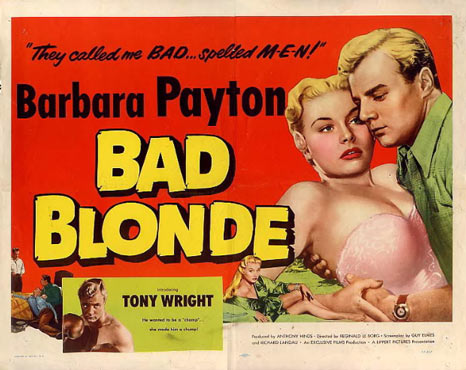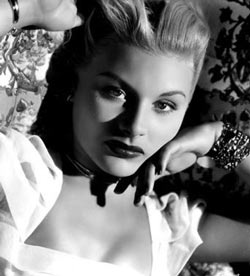
On the other level, it is a time capsule that captures a very troubled woman at a very troubled time in her life. The star of the film, Barbara Payton, was on a downward slope as she worked on this production, a slope that would only get steeper as the years progressed. The film is built around her bad girl image, an image that in many ways was all too real.
Bad Blonde is also an example of a fascinating subspecies of noir that emerged in the early fifties: the Anglo-American coproduction. In 1950, Hammer Films went into the crime movie business with the American B-movie producer Robert L. Lippert. Over the next few years Lippert would ship his English associates a long line of fading Hollywood stars, as well as once promising second-string players who’d failed to become stars. People like Dan Duryea (Terror Street), Zachary Scott (Dead On Course), Lizabeth Scott and Paul Henreid (Stolen Face), and Dane Clark (Blackout) made the transatlantic flight into darkness as their careers slowed down.
Barbara Payton was in worse shape than most. Born Barbara Lee Redfield in Cloquet, Minnesota, she’d come to Hollywood only four short years before Bad Blonde. Possessed of an incredible, and somehow hauntingly vacant beauty, she’d burned hard and bright for a about a year, grabbing attention as the good-girl-gone-bad in the Cagney noir Kiss Tomorrow Goodbye. Though it was a good start in the business, her personal life was already plagued by a drinking problem and a weakness for the wrong men. After being passed around as the Saturday night girl-toy of rich skirt-chasers like Howard Hughes and Bob Hope (she blackmailed the married Hope), and moonlighting as the playmate of B-list sexaholics like Steve Cochrane and John Ireland, she landed in a love/hate triangle with the past-his-prime actor Franchot Tone and the washed-up B-list actor Tom Neal. This led to an incident in which Tone and 
It was this Barbara Payton who went to England to make a little boxing and infidelity flick called The Flannigan Boy (its underwhelming original English title). The film stars handsome young Tony Wright as an aspiring boxer named Johnny Flannigan who gets involved with a gregarious boxing promoter named Giuseppe Vecchi (Frederick Valk) and his sexy, much younger wife played by Payton.
As with much of the Hammer/Lippert output, Bad Blonde is a well made variation on the film noir. Director Reginald Le Borg has an instinctive feel for the material, and his film is sexy, well paced, and exciting. The murder of Giuseppe, alone aboard a little fishing raft in the middle of the lake, is about as well done as these things get. The secret weapon of the film is the gifted cinematographer Walter J. Harvey, the man responsible for giving much of Hammer Noir its dark hue. As he did in films like Stolen Face and Blackout, Harvey gives Bad Blonde a gorgeous palette of rich blacks and shimmering whites. The look of the film is at once English-countryside pretty and deeply noir.
The main reason to see Bad Blonde, however, remains the bad blonde at its center. Her youthful sheen is already gone and her face is starting to look puffy and wan, yet she is fully possessed, a perfect match for the role of a gold digger on her way to the gallows. After this she would close out her career with a handful of forgettable films and then descend into a sad final spiral. After 1955’s Murder is My Beat she couldn’t get another acting gig, no matter how low rent. Before long, she was turning tricks for five dollars down on the Sunset Strip. Sexual abuse and an addiction to heroin and alcohol decimated her body, and she was found passed out behind a dumpster in the parking lot of an A&P in 1967. A few weeks later, she was dead of liver failure. She was only 39. Bad Blonde is an artifact of her life at the point where everything had gone wrong. Perhaps because of this, her desperation feels authentic. Never a great actress, she doesn’t really seem to be acting here. She just seems like Barbara Payton.
Other Barbara Payton Noirs:
1. Trapped (1949) – Directed by noir master Richard Fleischer, this is an early example of the semi-documentary noirs that would flourish in the early fifties. Payton stars as a nightclub cigarette girl mixed up with a scumbag counterfeiter played by the delightfully nasty Lloyd Bridges. She’s luminous here—it’s easy to see why she shot to stardom so soon after hitting Hollywood.
2. Kiss Tomorrow Goodbye (1950) – With her performance as Holiday, a good-girl-gone-bad who falls in love with scumbag James Cagney, Payton made her big splash in films. The ripples would disappear almost overnight because her notorious sex-and-drug-fueled personal life almost immediately turned her into a gossip column punch line (“Queen Of The Nightclubs” read one headline), but that shouldn’t obscure how striking she is here. Young and beautiful, she’s more fiery here than she’d ever be onscreen again.
3. Murder Is My Beat (1955) – Payton’s last film was a lackluster mystery about honest cop Ray Patrick (Paul Langton) who tracks down a murder suspect with the impressive name of Eden Lane (Barbara Payton). She protests her innocence and he believes her, so together the honest cop and the sexy murder suspect go on the lam to try and clear her name. Though it’s helmed by the great Poverty Row director Edgar G. Ulmer this is a stinker. Lots of crappy back projection and clunky dialog. Worst of all, in a colorless performance, Payton simply looks spent. Skip this one unless you’re a completist.
Jake Hinkson, The Night Editor, is the author of Hell on Church Street.
Read all posts by Jake Hinkson on Criminal Element.

PS: I can’t reccomend highly enough John O’Dowd’s wonderful biography of Payton [url=http://books.google.com/books?id=yzQhGQAACAAJ&dq=kiss+tomorrow+goodbye&hl=en&sa=X&ei=aSCgULPsEtKB0AGdj4GgAw&ved=0CDMQ6AEwAg]KISS TOMORROW GOODBYE: THE BARBARA PAYTON STORY[/url]. It’s a heartbreaking story, but I think it’s easily the best thing written about the queen of the hard-luck ladies of noir.
Thank you very much, Jake, for this great piece on Barbara, AND for mentioning my book. I tried very hard to do right by her, and to bring some understanding to her life, and your support of the book makes me feel great.
There’s a feature-length documentary on Barbara’s life and career currently in the works in Los Angeles , as well as another film project — a straight biopic — so maybe Barbara’s biggest and brightest moments in the sun are still to come.
Thank you for writing this beautiful essay on a lady who will probably continue to fascinate me until the day I die.
Wishing you all the best,
John O’Dowd
[url=mailto:jod6cindy@aol.com]jod6cindy@aol.com[/url]